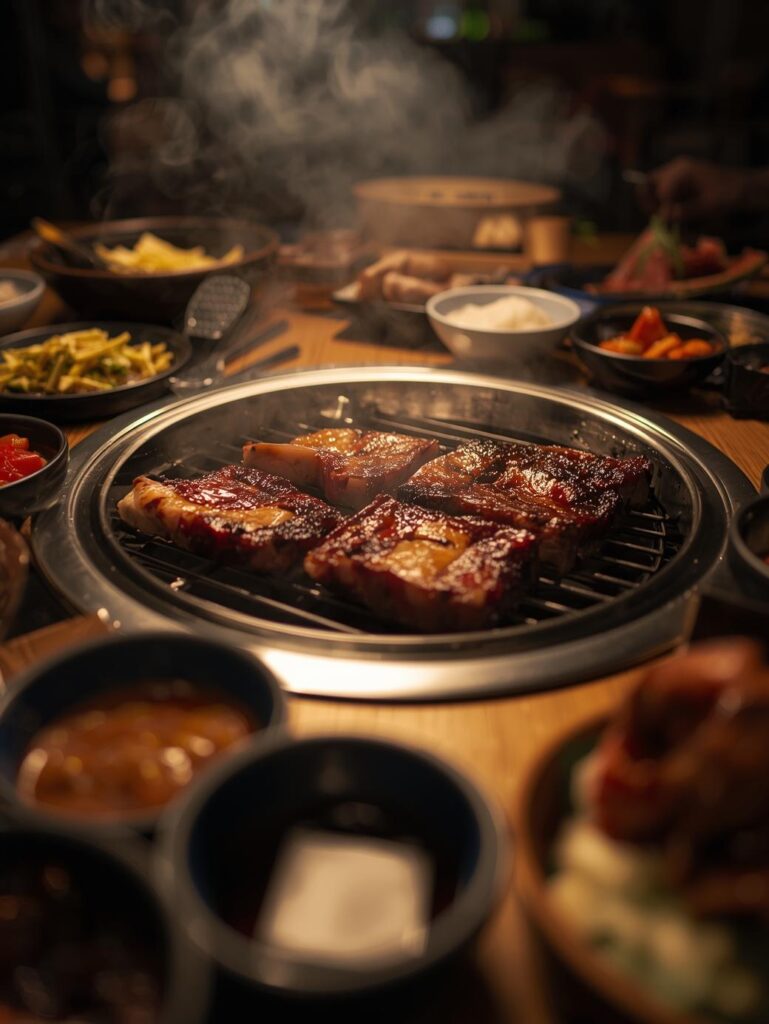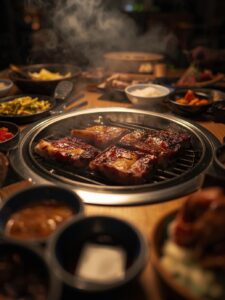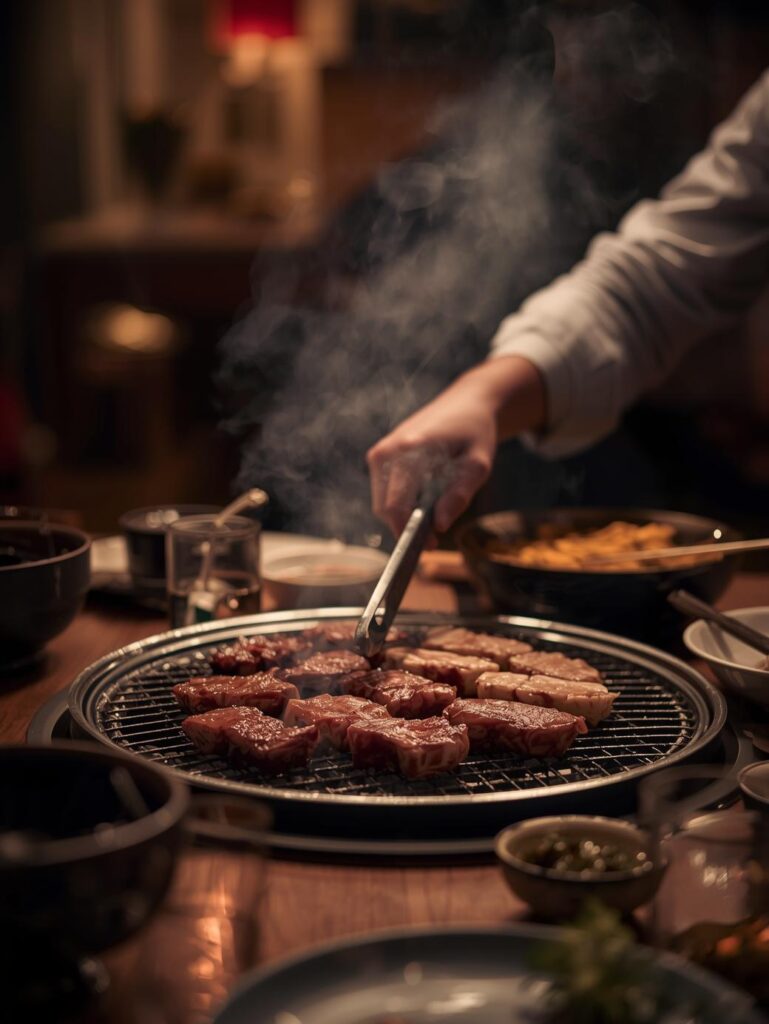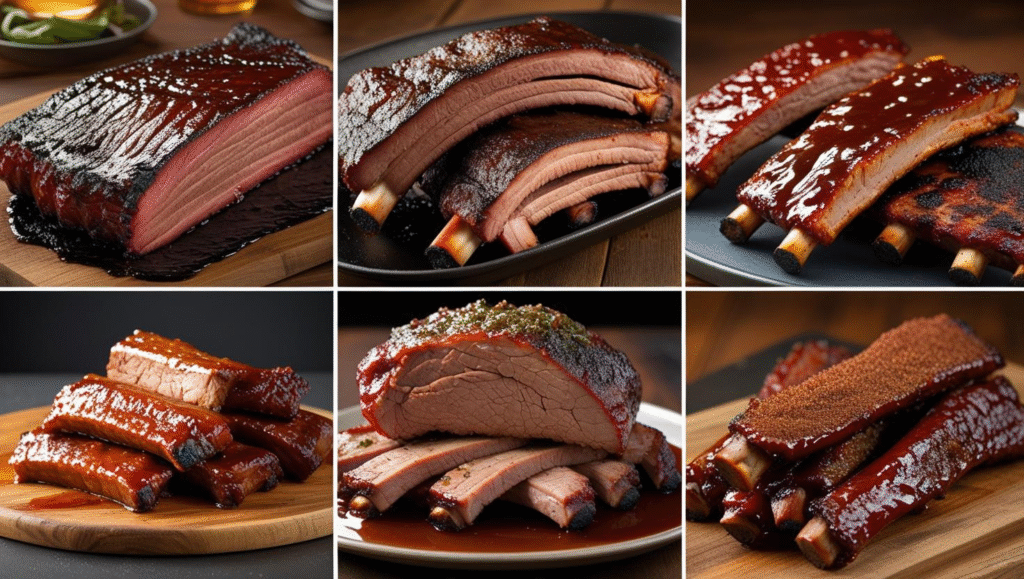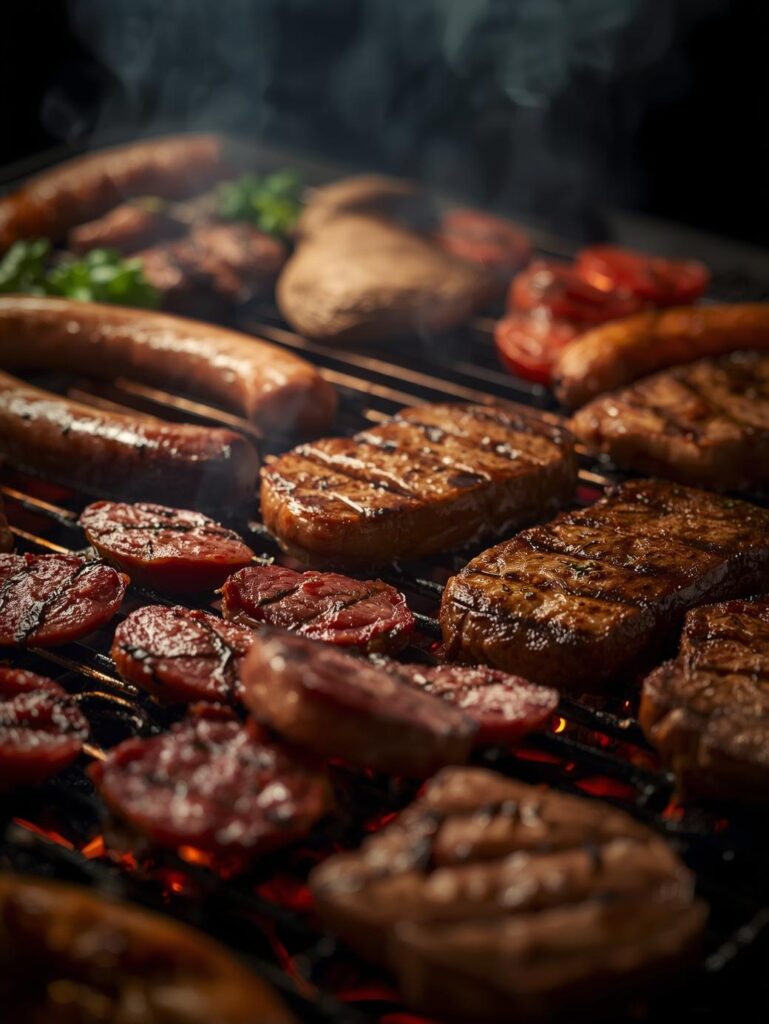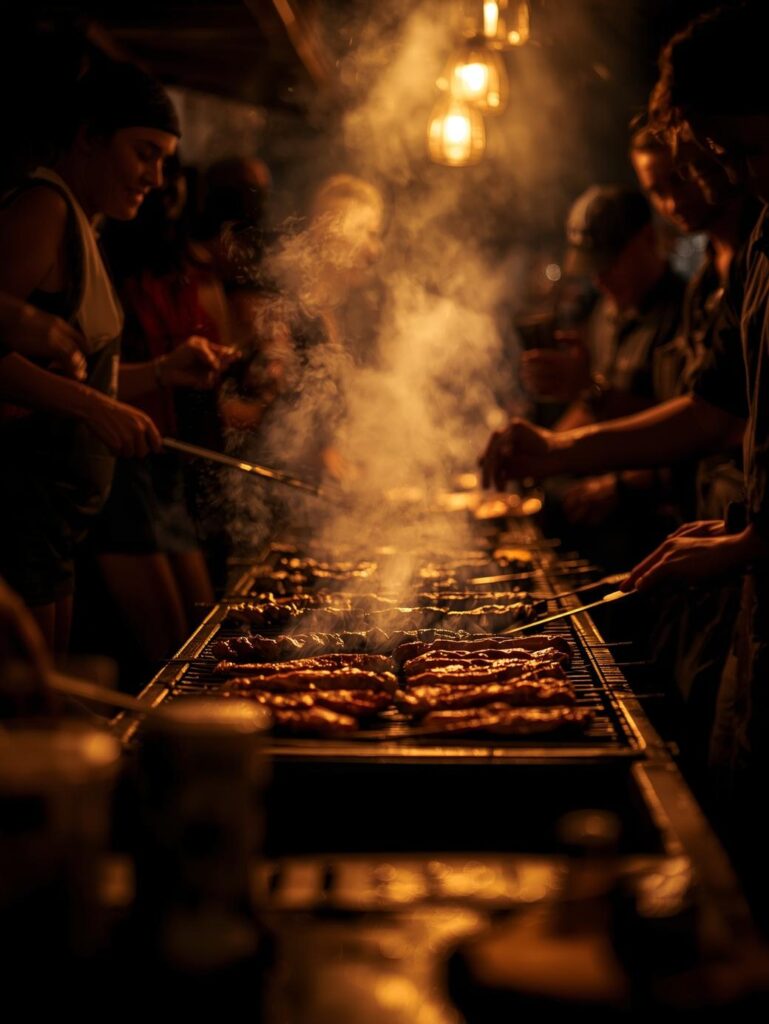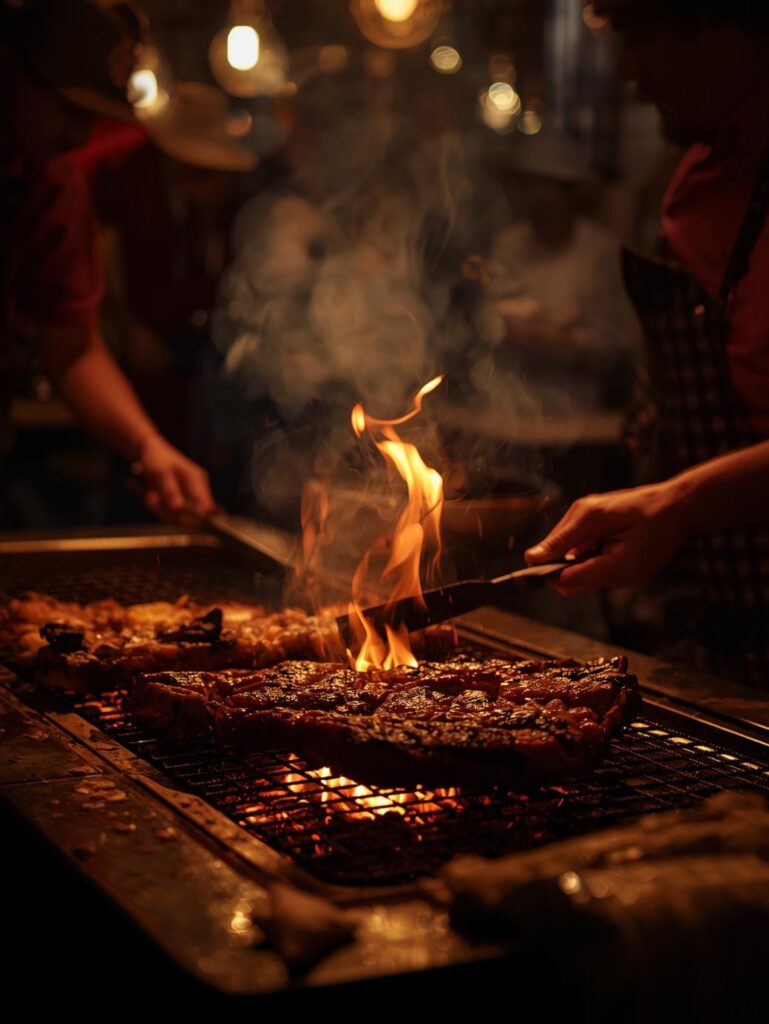Asian BBQ Expert’s Note: This guide continues our global BBQ series with one of the world’s most interactive and flavorful dining experiences. Korean BBQ isn’t just cooking—it’s a social event where the table becomes the kitchen and every diner becomes their own chef. While American BBQ focuses on low-and-smoke and Brazilian churrasco emphasizes fire and salt, Korean BBQ celebrates the marriage of sweet-savory marinades, precision-cut meats, and the communal joy of cooking together.
Korean BBQ at Home: Cuts, Marinades, and Tabletop Grilling Mastery
“In Korea, BBQ isn’t something you eat—it’s something you do. The sizzle of marinated beef hitting the grill, the scent of garlic and sesame filling the air, the shared excitement of building the perfect lettuce wrap—this is dining as theater. While others stand watch over solitary smokers for hours, Koreans have perfected the art of the instant feast, where the cooking is as immediate as the craving and every bite is customized to personal taste.”
Korean BBQ at Home: Cuts, Marinades, and Tabletop Grilling Mastery
Download the Korean BBQ Cuts Guide & Marinade Recipes
Annyeonghaseyo and welcome to the world of Korean BBQ—where thin-sliced meats meet complex marinades and every meal becomes an interactive celebration. This isn’t just grilling; it’s a culinary performance where the boundaries between kitchen and dining room disappear, and the focus shifts from slow-cooked perfection to instant gratification with maximum flavor. This guide will transform your understanding of home grilling, teaching you how to recreate the authentic Korean BBQ experience right at your dining table.
Understanding Korean BBQ means embracing the social and interactive nature of the meal.
⚙️ The Four Pillars of Korean BBQ Culture
Community, Balance, Interaction, and Speed
- The Shared Experience: Korean BBQ is fundamentally social—the cooking happens at the table, with everyone participating. It’s as much about bonding as it is about eating.
- The Balance Principle: Every element serves a purpose. Rich meats are balanced by crisp vegetables, spicy sauces are tempered by mild rice, and fatty cuts are cut by sharp kimchi.
- Instant Gratification: Unlike American BBQ’s hours-long waits, Korean BBQ delivers immediate results. Thin-sliced meats cook in seconds, satisfying cravings instantly.
- The DIY Spirit: Every diner becomes their own chef, cooking meat to their preferred doneness and building custom lettuce wraps (ssam) with their chosen combinations.
🎯 Korean BBQ vs. Other Grilling Traditions
🇺🇸 American BBQ
- Thick cuts, low & slow
- Dry rubs, smoke flavor
- Individual portions
- Cook serves diners
- Single protein focus
🇰🇷 Korean BBQ
- Thin slices, hot & fast
- Wet marinades, sear flavor
- Shared family-style
- Diners cook themselves
- Multiple proteins
🔪 THE KOREAN BBQ LEXICON: SPEAKING THE LANGUAGE
First rule of Korean BBQ mastery: learn the terms or risk menu confusion.
🗣️ Essential Korean BBQ Terminology
Master the Vocabulary of Tabletop Grilling
- Bulgogi (The Classic): “Fire meat”—thinly sliced beef marinated in sweet soy sauce. The gateway to Korean BBQ.
- Galbi/Galbi-gui (The Star): Marinated beef short ribs, either LA-style (cross-cut) or traditional (whole ribs).
- Samgyeopsal (The Pure): Unseasoned pork belly—the ultimate test of quality meat and perfect grilling technique.
- Ssam (The Wrap): Lettuce wraps filled with meat, rice, and condiments—the signature Korean BBQ eating style.
- Banchan (The Sides): The array of small side dishes that accompany Korean BBQ—kimchi, bean sprouts, spinach, etc.
- Ssamjang (The Sauce): The thick, spicy paste used in ssam—a mix of doenjang (soybean paste) and gochujang.
- Dwaeji-gogi (Pork): General term for pork BBQ, including marinated pork neck (mok-sal).
- Gogi-gui (The Method): Literally “meat roast”—the general term for Korean BBQ.
📊 The Korean BBQ Cuts Matrix: Choosing Your Proteins
🎯 Understanding the Korean BBQ Protein Spectrum
| Cut | Korean Name | Description | Best For | Marinade Style |
|---|---|---|---|---|
| Beef Short Ribs | LA Galbi | Cross-cut ribs, 1/4″ thick with 3 bones | Classic experience, rich flavor | Sweet soy-based |
| Ribeye/Brisket | Chadolbaegi | Paper-thin slices, almost transparent | Quick cooking, light option | None or light salt |
| Pork Belly | Samgyeopsal | Thick slices, equal fat/meat layers | Crispy skin lovers | None (salt/sesame oil) |
| Pork Neck | Mok-sal | Lean, tender, minimal fat | Health-conscious | Spicy gochujang |
| Beef Sirloin | Bulgogi | Thin slices, well-marbled | Beginners, family-friendly | Sweet soy classic |
| Chicken Thigh | Dak-gui | Boneless, skin-on preferred | Lighter alternative | Spicy or soy-garlic |
🔥 THE HOME KOREAN BBQ SETUP: AUTHENTIC VS ADAPTED
You don’t need specialized equipment to create an authentic Korean BBQ experience.
🎪 Professional Tabletop Grill Setup
The Restaurant Experience at Home
- Butane Gas Grill: The most common home setup. Portable, adjustable heat, easy cleanup. Look for models with drip trays and removable grates.
- Charcoal Tabletop: The premium choice for flavor. Small charcoal grills like the “Korean BBQ mini grill” provide authentic smokiness but require more effort.
- Electric Grill Plates: Indoor-safe option with non-stick surfaces. Less authentic flavor but convenient for apartment living.
- Ventilation is Key: Even with electric grills, you’ll need good ventilation. Open windows, use stove vents, or consider outdoor setup for gas/charcoal.
- The Side Compartments: Many Korean grills have moats for egg or cheese around the edges—a popular restaurant addition.
🎪 Improvised Home Setup
No Special Equipment? No Problem
- Cast Iron Skillet: Heat on a portable burner or stovetop. Provides excellent sear and even heating.
- Electric Griddle: Large surface area for multiple people. Easy temperature control and cleanup.
- Raclette Grill: The Swiss solution that works surprisingly well for Korean BBQ with its tabletop design.
- Outdoor Grill + Table: Cook on your regular grill and bring plates to the table. Less interactive but same flavors.
- Hot Plate Method: Basic electric hot plate with cast iron or steel plate. Budget-friendly and effective.
🌊 THE MARINADE MASTERY: BUILDING KOREAN FLAVORS
Korean BBQ marinades balance sweet, savory, salty, and umami in perfect harmony.
🥩 Bulgogi Marinade (Sweet Soy)
The Classic Gateway Marinade
- Soy Sauce (1 cup): Use Korean soup soy sauce (guk-ganjang) for authenticity, or low-sodium Japanese soy sauce.
- Asian Pear (1/2): The secret tenderizer. Grated pear provides enzymes and natural sweetness.
- Brown Sugar (3 tbsp): Balances saltiness and promotes caramelization.
- Sesame Oil (2 tbsp): Toasted sesame oil for nutty aroma.
- Garlic (6 cloves): Minced fresh garlic—non-negotiable.
- Ginger (1 tbsp): Fresh grated ginger for brightness.
- Green Onions (3): Thinly sliced for fresh onion flavor.
- Black Pepper (1 tsp): Freshly ground for subtle heat.
🌶️ Gochujang Marinade (Spicy)
The Bold and Spicy Option
- Gochujang (1/2 cup): Korean red chili paste—the soul of the marinade.
- Soy Sauce (1/4 cup): Provides saltiness and umami base.
- Mirin (3 tbsp): Sweet rice wine for balance and shine.
- Sesame Oil (2 tbsp): Toasted variety for depth.
- Garlic (4 cloves): Minced—doubles down on the spice.
- Brown Sugar (2 tbsp): Counters the heat and helps glazing.
- Rice Vinegar (1 tbsp): Adds brightness to cut through richness.
- Gochugaru (1 tbsp): Korean chili flakes for extra heat and texture.
🥬 THE SSAM (WRAP) SYSTEM: BUILDING PERFECT BITES
The art of the ssam is what makes Korean BBQ uniquely interactive and customizable.
🎪 The Ssamjang Sauce Foundation
The Glue That Holds Everything Together
- Doenjang (3 tbsp): Korean fermented soybean paste—the umami base.
- Gochujang (2 tbsp): Korean chili paste for heat and complexity.
- Sesame Oil (1 tbsp): Toasted variety for nutty aroma.
- Minced Garlic (2 cloves): Fresh for pungent kick.
- Rice Vinegar (1 tsp): Brightness to balance fermentation.
- Honey (1 tsp): Touch of sweetness to round flavors.
- Sesame Seeds (1 tsp): Toasted for crunch and visual appeal.
- Water (1-2 tbsp): To reach desired consistency.
🎪 The Perfect Ssam Assembly Line
Building Your Custom Wrap
- Lettuce Selection: Butter lettuce (soft, pliable), red leaf lettuce (colorful, mild), or perilla leaves (distinctive minty flavor).
- Rice Base: Short-grain white rice, slightly warm. Acts as flavor carrier and textural contrast.
- Protein Layer: Freshly grilled meat, cut into bite-sized pieces if necessary.
- Sauce Application: Dot with ssamjang—not too much, it’s potent!
- Vegetable Accents: Garlic slices, jalapeño rings, green onion threads, or kimchi.
- The Wrap Technique: Fold like a taco, not a burrito. One-handed eating is the goal.
- The One-Bite Rule: Perfect ssam should be consumed in one satisfying bite.
📋 THE ULTIMATE KOREAN BBQ AT HOME TIMELINE
The 4-Hour Journey to Korean BBQ Perfection
Prep Phase (2-4 hours before)
Slice meat, prepare marinades, make banchan, set up station.
Marinade Time (1-4 hours)
Marinate meats, prepare ssam ingredients, cook rice.
Table Setup (30 min before)
Arrange banchan, heat grill, organize ingredients family-style.
Interactive Dining (1-2 hours)
Grill, eat, socialize, repeat. The main event!
🚨 KOREAN BBQ TROUBLESHOOTING: COMMON MISTAKES & SOLUTIONS
🎯 Fixing Common Korean BBQ Problems
| Problem | Korean Description | Cause | Solution |
|---|---|---|---|
| Tough Meat | “Gogi-ga ttatteuthae” | Wrong cut, thick slices, no pear | Thinner slices, Asian pear, better cuts |
| Burnt Marinade | “Taewooss-eo” | Too much sugar, high heat | Lower heat, less sugar, wipe excess |
| Smoky Indoor | “Yesutab-e gyesida” | Poor ventilation, fatty meats | Better ventilation, outdoor setup, leaner cuts |
| Soggy Lettuce | “Sangchiga heullin” | Wet lettuce, poor storage | Dry thoroughly, ice bath crisp |
| Overwhelming Smoke | “Nae gae gyesig” | Fat dripping, high heat | Trim fat, moderate heat, use drip pan |
🏁 MASTERING THE KOREAN BBQ EXPERIENCE AT HOME
Mastering Korean BBQ at home means embracing a completely different philosophy of dining—one where the journey is as important as the destination, where cooking becomes social entertainment, and where every diner becomes an active participant in creating their perfect meal. This isn’t just about replicating restaurant flavors; it’s about creating the joyful, interactive experience that makes Korean BBQ so special.
Your Korean BBQ journey starts with understanding that the equipment matters less than the spirit of shared experience. Then comes mastering the marinades that make the meats sing and the ssam system that lets everyone customize their perfect bite. Finally, you’ll discover the joy of turning dinner into an event where the cooking is part of the entertainment and every meal feels like a celebration.
So gather your friends and family, fire up that tabletop grill, and remember the three rules of Korean BBQ mastery: slice thin, marinate boldly, and always eat with joy. Your journey to becoming a Korean BBQ host starts now.
🇰🇷 START WITH BULGOGI MARINADE →
Master the classic sweet soy marinade that’s the gateway to Korean BBQ
Explore More Asian BBQ Traditions: Continue your journey through Asia’s fire cuisine.

